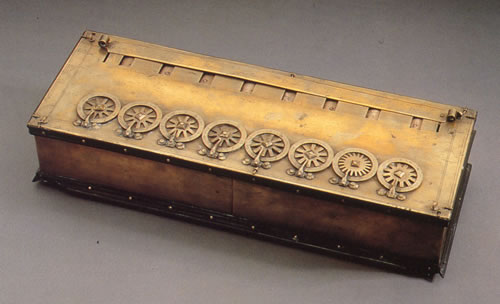Some examples from the feature;
 The 2000 year old Antikythera Mechanism, the worlds oldest computing device (and 1000 years more advanced than comparable mechanisms). Only discovered 100 years ago in a shipwreck.
The 2000 year old Antikythera Mechanism, the worlds oldest computing device (and 1000 years more advanced than comparable mechanisms). Only discovered 100 years ago in a shipwreck. Wilhelm Schickard’s Calculating Clock (1632) that could add and subtract six-digit numbers (with a bell as an overflow alarm). This invention was used by his friend, astronomer Johannes Kepler, to calculate astronomical tables, which was a big leap for astronomy at the time. For this, Wilhelm Schickard was considered by some to be the "Father of Computer Age."
Wilhelm Schickard’s Calculating Clock (1632) that could add and subtract six-digit numbers (with a bell as an overflow alarm). This invention was used by his friend, astronomer Johannes Kepler, to calculate astronomical tables, which was a big leap for astronomy at the time. For this, Wilhelm Schickard was considered by some to be the "Father of Computer Age." Blaise Pascal’s Pascaline (or Arithmetique) from 1645 - The basic mechanism of the Pascaline is a series of gears - when the first gear with ten teeth made one rotation (one to ten), it shifts a second gear until it rotated ten times (one hundred). The second gear shifted a third one (thousands) and so on. This mechanism is still in use today in car odometers, electricity meters and at the gas pumps.
Blaise Pascal’s Pascaline (or Arithmetique) from 1645 - The basic mechanism of the Pascaline is a series of gears - when the first gear with ten teeth made one rotation (one to ten), it shifts a second gear until it rotated ten times (one hundred). The second gear shifted a third one (thousands) and so on. This mechanism is still in use today in car odometers, electricity meters and at the gas pumps. German mathematician Gottfried Wilhelm Leibniz' Stepped Reckoner of the 17th century was inspired by a steps-counting machine (pedometer) he saw to build his own calculator. Leibniz’s design used a special type of gear called the Stepped Drum or Leibniz wheel, a cylinder with nine bar-shaped teeth along its length.
German mathematician Gottfried Wilhelm Leibniz' Stepped Reckoner of the 17th century was inspired by a steps-counting machine (pedometer) he saw to build his own calculator. Leibniz’s design used a special type of gear called the Stepped Drum or Leibniz wheel, a cylinder with nine bar-shaped teeth along its length. Charles Babbage’s Difference Engine from 1822 was considered one of the first mechanical computers. Despite of its unwieldy design, his plan called for a basic architecture very similar to that of a modern computer.
Charles Babbage’s Difference Engine from 1822 was considered one of the first mechanical computers. Despite of its unwieldy design, his plan called for a basic architecture very similar to that of a modern computer. During World War II, Nazi Germany used an electro-mechanical cipher machine called Enigma to encrypt and decrypt coded messages. It used rotors to substitute letters (for example, an "E" might be coded as "T"). The genius of the Enigma was that the machine used polyalphabetic cipher, where the rotation of the rotors allowed each subsequent letters to be encoded in a different manner. (For example, "EEE" might be become "TIF").
During World War II, Nazi Germany used an electro-mechanical cipher machine called Enigma to encrypt and decrypt coded messages. It used rotors to substitute letters (for example, an "E" might be coded as "T"). The genius of the Enigma was that the machine used polyalphabetic cipher, where the rotation of the rotors allowed each subsequent letters to be encoded in a different manner. (For example, "EEE" might be become "TIF").See the rest, including the dawn of digital computing here-->Link
via BoingBoing from Neatorama
See also;
All Watchmaking Posts
History of the First Digital Calculator Watches
1960s Juvenia Protractor Watch
Multi-Functional Watches
Slide Rule Wristwatches
Gadget Timepieces
| Watchismo Blog | Watchismo Shop | Contact Us | Subscribe |
